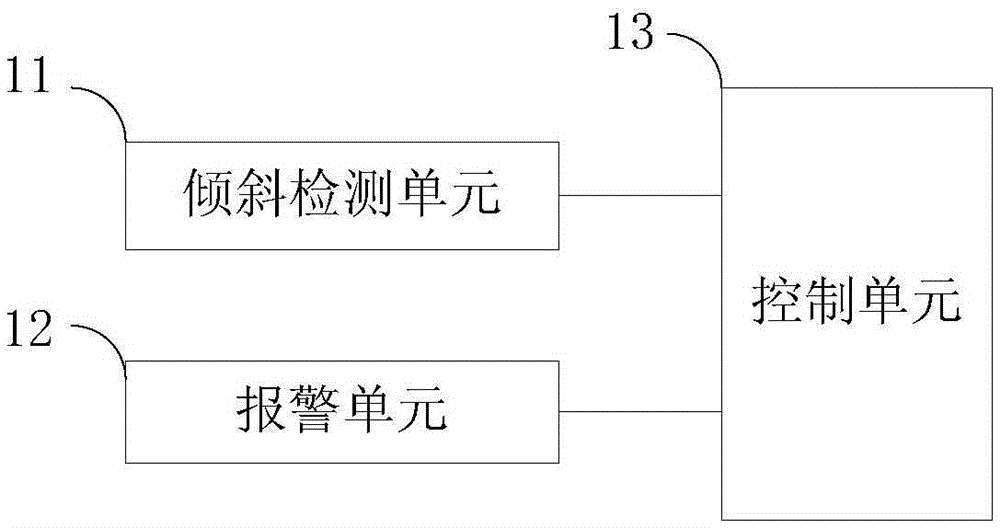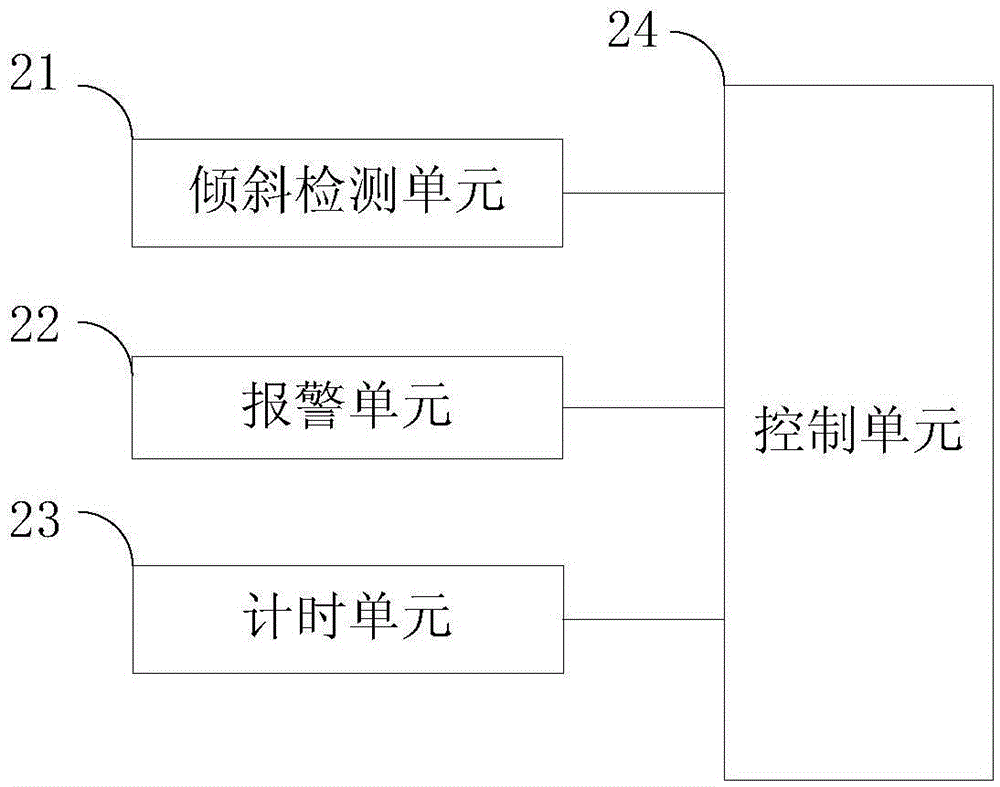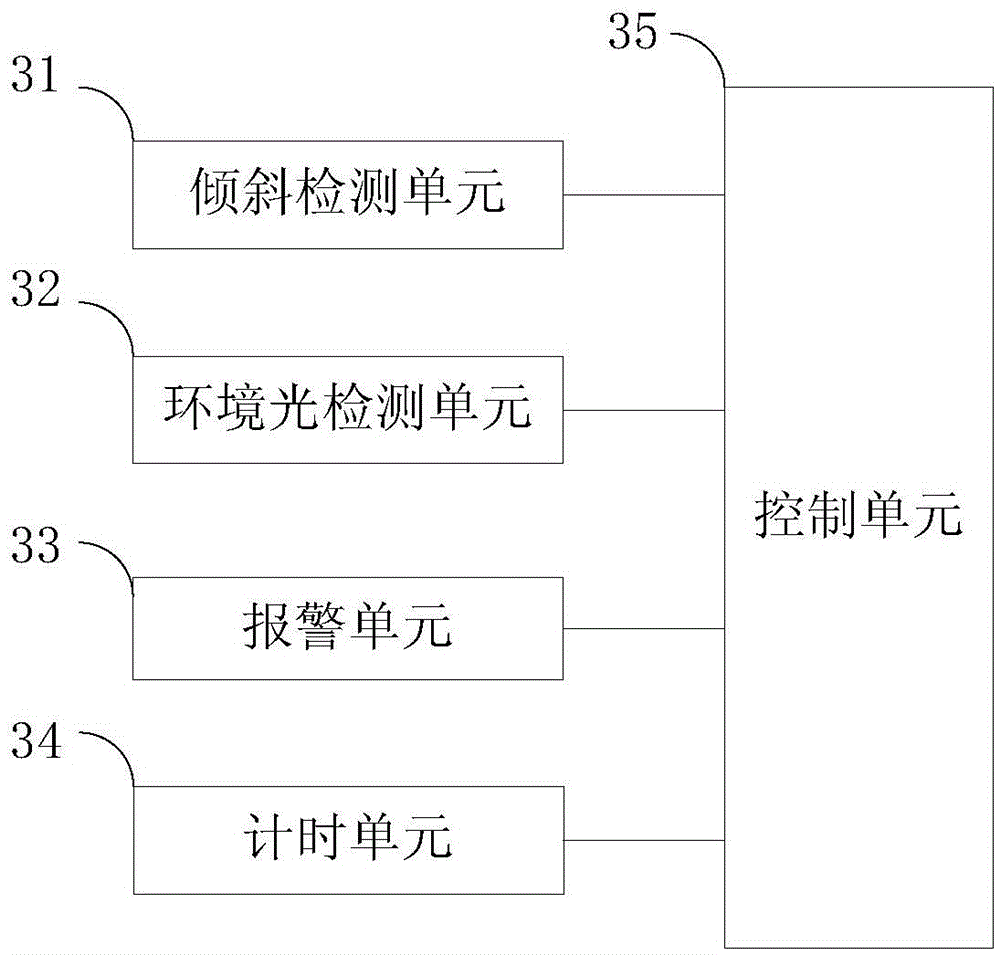Intelligent glasses
A technology of smart glasses and an alarm unit, which is applied in the directions of glasses/goggles, non-optical accessories, optics, etc., can solve the problems of occupying table and chair space, inconvenient use, etc., and achieves high alarm accuracy, easy portability and simple structure. Effect
- Summary
- Abstract
- Description
- Claims
- Application Information
AI Technical Summary
Problems solved by technology
Method used
Image
Examples
Embodiment 1
[0041] This embodiment provides a smart glasses 1, such as figure 1 As shown, the tilt detection unit 11, the alarm unit 12 and the control unit 13 are included. The control unit 13 is connected to the tilt detection unit 11 and the alarm unit 12. The tilt detection unit 11 is used to detect the tilt degree of the smart glasses 1 to obtain a tilt angle. In the tilt detection unit 11, a three-axis acceleration sensor can be used to detect the acceleration of the XYZ axis of the smart glasses 1 in real time or at a timing, and use the acceleration data in combination with methods known in the art to calculate the tilt of the smart glasses 1 relative to a reference surface such as a horizontal plane. And send the inclination angle value to the control unit 13. The control unit 13 receives the inclination angle value sent by the inclination detection unit 11, compares the inclination angle value with a preset angle threshold, and determines whether the inclination angle value is gr...
Embodiment 2
[0047] This embodiment provides a smart glasses 2, such as figure 2 As shown, the tilt detection unit 21, the alarm unit 22, the timing unit 23 and the control unit 24 are included. That is to say, compared with the smart glasses 1 of the embodiment 1, the smart glasses 2 of this embodiment are different in that it also includes a timing unit 23 for accumulating the tilt time for which the tilt angle continues to be greater than the preset angle threshold, and The control unit 24 is also different from the control unit 13 in Embodiment 1. The control unit 24 is used to determine whether the tilt time is greater than the preset time threshold. When the tilt time is greater than the preset time threshold, the alarm unit 22 is controlled to issue an alarm signal. When the tilt time is less than or equal to the preset time threshold, the alarm unit 22 is controlled to stop sending an alarm signal. The preset time threshold here is preferably 5 seconds.
[0048] Preferably, the smar...
Embodiment 3
[0053] This embodiment provides a smart glasses 3, such as image 3 As shown, a tilt detection unit 31, an ambient light detection unit 32, an alarm unit 33, a timing unit 34, and a control unit 35 are included. That is to say, compared with the smart glasses 2 of the embodiment 2, the smart glasses 3 of this embodiment is different in that it further includes an ambient light detection unit 32, which is used to detect the intensity of the ambient light around the smart glasses 3 , The ambient light detection unit 32 detects the light intensity of the ambient light around the smart glasses 3 in real time or regularly, and sends the detection result to the control unit 35. The control unit 35 is connected to the ambient light detection unit 32, and the control unit 35 receives the ambient light detection The detection result of the unit 32 compares the detection result with the preset light intensity threshold to determine whether the light intensity of the ambient light is less ...
PUM
 Login to View More
Login to View More Abstract
Description
Claims
Application Information
 Login to View More
Login to View More - R&D
- Intellectual Property
- Life Sciences
- Materials
- Tech Scout
- Unparalleled Data Quality
- Higher Quality Content
- 60% Fewer Hallucinations
Browse by: Latest US Patents, China's latest patents, Technical Efficacy Thesaurus, Application Domain, Technology Topic, Popular Technical Reports.
© 2025 PatSnap. All rights reserved.Legal|Privacy policy|Modern Slavery Act Transparency Statement|Sitemap|About US| Contact US: help@patsnap.com



